A Quick Note Before We Dive In
I want to start by saying this: I’ve used the Màbe carrier multiple times over the course of more than a year. I’ve owned both their first version (from an earlier factory) and one of their newer models. My goal here isn’t to convince you one way or the other, but to give you the full picture- the pros, the cons, the context- so you can make the choice that’s right for your family.
When my sister-in-law had her baby after a c-section, I gifted her one of my Màbe carriers. She wasn’t babywearing during her first month of recovery, but when she was ready, I thought the Màbe would be a good option because of its soft, squishy waistband. It doesn’t feel as firm or supportive as something like a Tula, but in those early months, that softer style can be more forgiving on a healing body.
My Experience With the Màbe Carrier
When I first tried the original version of the Màbe, I honestly didn’t think it was anything special. It felt like a basic soft-structured carrier with no unique features. The overall quality reminded me of what you might get from budget lines like MomCozy — functional, but not standout.
That said, their newest model does have clear improvements. The two main upgrades I noticed are:
Webbing: The straps feel sturdier and smoother than the earlier version.
Safety elastic: A small but important detail added to give extra reassurance when buckling.
These upgrades make the carrier feel noticeably better than the first version I owned, and I do think the webbing in particular is a genuinely more expensive component than what you’ll find in most budget carriers.
Still, even with those changes, the design itself is identical to many other carriers widely available online. There’s nothing original or innovative about the structure. But what Màbe offers that random Amazon or Alibaba versions may not is safety testing and some thoughtful finishing touches.
Fit and Function
Newborn Fit: The Màbe is not ideal for very small babies. The panel adjusts in width but not in height, so it often overwhelms newborns.
Back Carrying: Unlike some carriers that use Perfect Fit Adjusters (PFAs) to make shoulder straps more snug, the Màbe does not include them. Without PFAs or a chest clip, the straps can slip off shoulders if not monitored carefully.
Waistband: The soft waistband can feel gentle postpartum, but it has a tendency to roll. Some parents also report — and I’ve experienced — that the Velcro section can start poking over time.
Slim Fit: On my US size 0–2 frame, I can’t get the waistband or shoulder straps snug enough, especially for back carrying. This makes it feel loose and less secure for petite wearers. By comparison, Happy Baby (with its apron-style waistband, great for short torsos) and Lenny Lamb (with more adjustable panels) fit much more securely.
As Baby Grows: I did find that as my baby got bigger, I was able to achieve a slightly better fit in a front carry, even with my slimmer frame. However, the comfort level declined quickly. The waistband tends to curl and sink lower on my body, which places more downward pressure on my pelvic floor. Because the weight ends up concentrated into a narrow band, my body feels tired much faster than it does in most other carriers I use. On top of that, the placement of the webbing on the waistband — combined with how soft the foam is — creates a pressure point that leaves my low back fatigued more quickly than most other “waterfall” style waistbands.
Weight Range: Most parents find support starts to fade around 20–25 lbs. That doesn’t mean you can’t use it longer, but comfort often declines.
Pros and Cons of the Màbe Carrier
Pros
Simple and straightforward to use
Good entry-level option for new parents
Lightweight and soft on early postpartum bodies
Width adjustability for younger babies
Safety tested, unlike many lookalike carriers
Recent improvements (better webbing, added safety elastic)
Cons
Panel height overwhelms many newborns
No chest clip or PFAs → straps can slip in back carry
Waistband can roll; Velcro may poke some wearers
Comfort declines around 20–25 lbs
Waistband and shoulder straps often too loose for very slim frames (US size 0–2)
As babies grow, creates pelvic floor and low back fatigue faster than most carriers
Structurally identical to carriers sold much cheaper online (BUT, safety testing matters.)
Price inflated by branding and advertising (this is going to happen to all brands to a degree)
The Lawsuit and Design Origin
The lawsuit (find here) involving Màbe is part of what brought more attention to this design. In short:
Màbe originally sourced from a manufacturer (Sarah “Haixia” Wie).
After moving to another factory, Wie patented the design and had Amazon remove Màbe’s listings.
Màbe challenged, arguing this design had been widely available for years through other sellers.
The takeaway? This design is not unique to Màbe. It’s a white-label pattern that multiple brands can (and do) sell.
For many small babywearing businesses, this felt like a shift. Traditionally, brands poured energy into designing carriers that were truly different. The Màbe, by contrast, is mass-produced and marketed heavily- which has frustrated some in the community who feel it doesn’t bring anything new to the table.
That doesn’t mean it’s unsafe or useless. It just means it’s a basic, entry-level carrier, not a groundbreaking or luxury one.
Amazon vs. Màbe: A Side-by-Side Look
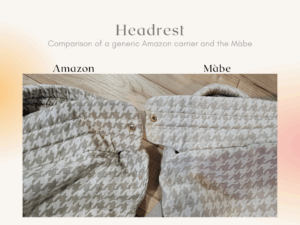
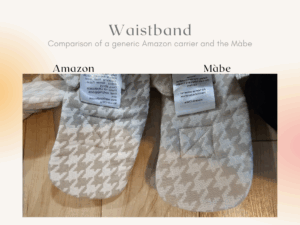
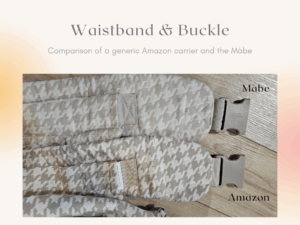
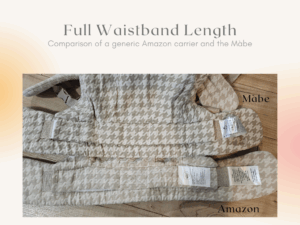
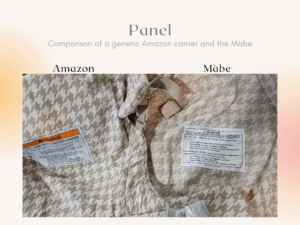
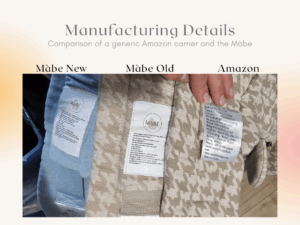
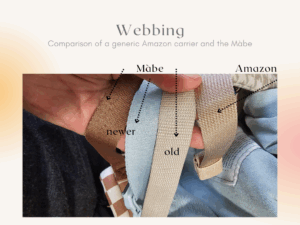
So, Why the Price Difference?
At the end of the day, what you’re paying for with Màbe isn’t originality. It’s:
Safety certifications (beyond fabric testing like Oeko-Tex — the actual carrier itself has been tested for safety)
Small quality upgrades (webbing, safety elastic)
Marketing and visibility (heavy investment in influencers and ads)
Other carriers with this same design may look identical and even feel similar, but if they haven’t undergone the same third-party safety testing, you don’t have the same guarantee of reliability.
Carrier Alternatives to Consider
If you like the Màbe’s look or simplicity but want more originality or long-term support, here are some alternatives worth considering:
Happy Baby – Minimalist, stylish, with an apron-style waistband that’s especially good for petite frames and short torsos.
👉 Use code LETSTALK10 at checkout for a discount.Lenny Lamb – Wide size range and toddler/preschool carriers. Their adjustable panels hug slim waists well.
👉 Use code LETSTALK_LENNY at checkout for a discount.Tula – Longstanding brand with original panel shaping. The Free to Grow is excellent for newborns.
Oscha – Artistic, community-driven wraps, slings, and structured carriers.
👉 Use code LETSTALK23 at checkout for a discount.Heritage Baby – Handmade, ergonomic carriers built with strong community ties.
👉 Use code LETSTALK at checkout for a discount.
| Carrier | Best For Slim Frames | Newborn Friendliness | Toddler Longevity | Overall Investment |
|---|---|---|---|---|
| Màbe | No – waistband & straps loose on petite bodies | Not ideal – panel height overwhelms small babies | Limited – support declines ~20–25 lbs | Entry-level, short-term |
| Happy Baby | Yes – apron-style waistband suits petite/short torsos | Good – snug fit and adjustable panel | Moderate – toddler years | Strong choice for petite parents |
| Lenny Lamb | Yes – adjustable panels/waist fit slim bodies well | Good – panel sizing + woven fabric | Excellent – toddler & preschool options | Great long-term option |
| Tula | Not always – waistband can gap on very slim waists | Good – Free-to-Grow for newborns | Excellent – toddler & preschool | Reliable, supportive, long-lasting |
| Oscha | Depends – wraps/slings can be snug | Excellent – from birth | Good – wraps adapt into toddlerhood | Artistic, community-driven |
| Heritage Baby | Depends – handmade variation, usually adjustable | Good – ergonomic panel sizing | Good – toddler options available | Handmade, ergonomic, unique |
Final Thoughts
The Màbe is not a luxury or innovative carrier — and it was never designed to be. It’s a basic, entry-level soft structured carrier that works for some families, especially in the earlier months.
If the style appeals to you and it fits your budget, and you want the reassurance of a safety-tested version of this design, then go for it. If you want something more original, longer-lasting, or tailored to slim frames, there are other carriers I’d recommend first.
Babywearing has always been about connection, practicality, and community. My goal here is simply to share my honest experience — not to sugarcoat, not to bash — so you have all the facts to make the choice that works best for your family.
And if you do choose the Màbe, you can use my code LETSTALK for a discount.


I just find it to be way too expensive for what it is. It’s not great but has a high price tag.
The price point is so high compared to other comparable ones!
I agree with the fit of mabe! I had to stop wearing it because it’s so uncomfortable on my body as my babies gotten older. My husband still uses it though. Definitely getting a better one for my self
I’m glad it’s still working for him- I do find men “tend* to be comfortable using it for longer. It doesn’t both my husband as much either- he also gets a much better fit with it.
I’m curious how it compares to the Wildbird Aerial Carrier. I feel like it’s marketed just as much, if not more.
I don’t think the Wildbird is perfect for everyone, but the quality on it is far superior to the Màbe. It is a unique, well designed carrier. I don’t find it to be the best fit on very slim frames, but I still get a much better fit. It’s also available in two different sizes which I appreciate. My biggest complaint with it is that it can feel a bit bulky. But I’ve been comfortable and supported when wearing it.
I need to do a full breakdown on that one too!
Thank you this was really helpful! I considered buying one and am thankful I didn’t, I think they’re something like $140? I ended up getting a Hope & Plum Lark carrier and find it pretty comfortable but my nearly 9-month old daughter is already almost 25 pounds and she’s getting too heavy to comfortably front carry for too long and I’ve been struggling getting her onto my back with the Lark. The only other carrier that I’ve back carried with is the Lillebaby 3 in 1 toddler carrier that I’ve used pretty heavily with my 4 year old and started wearing my youngest in on my back a few weeks ago. I usually put my kiddo on my hip, pull the carrier up over them, and kind of shimmy them onto my back while holding the straps up, but the Lark is less structured than the Lillebaby and I haven’t successfully gotten my youngest into a back carry with it yet. I love your page!